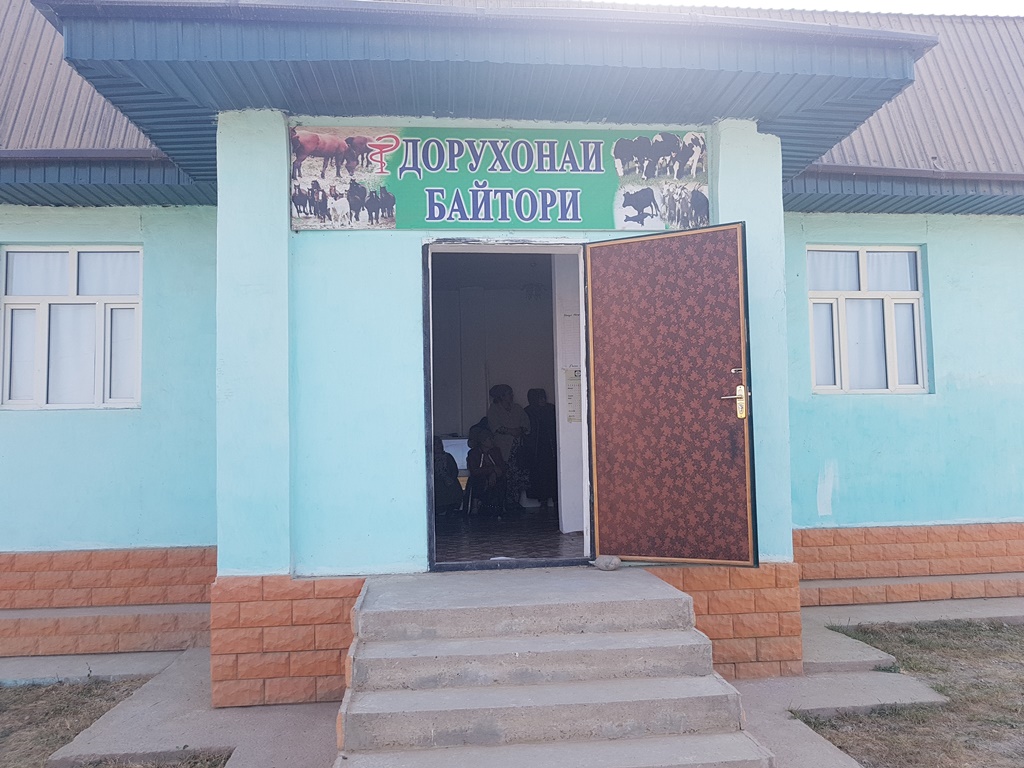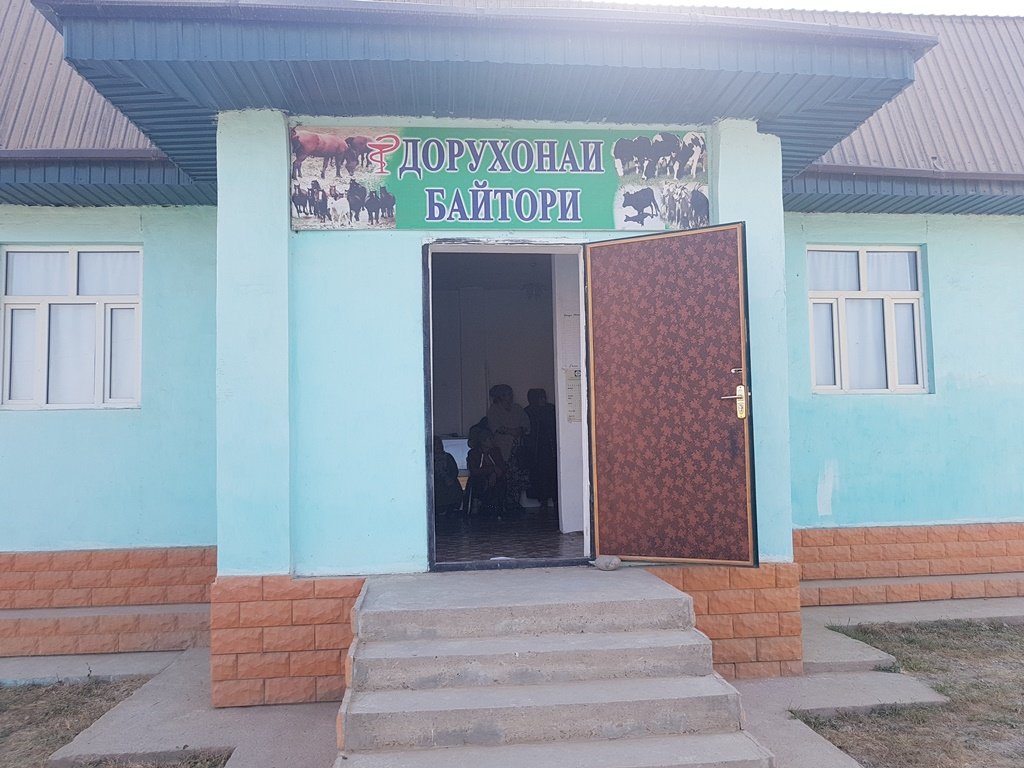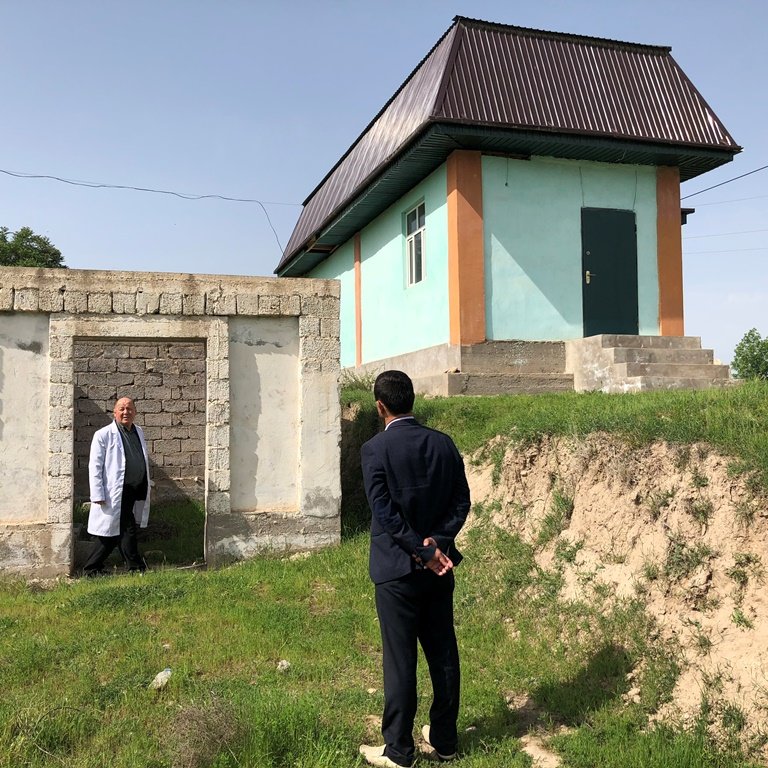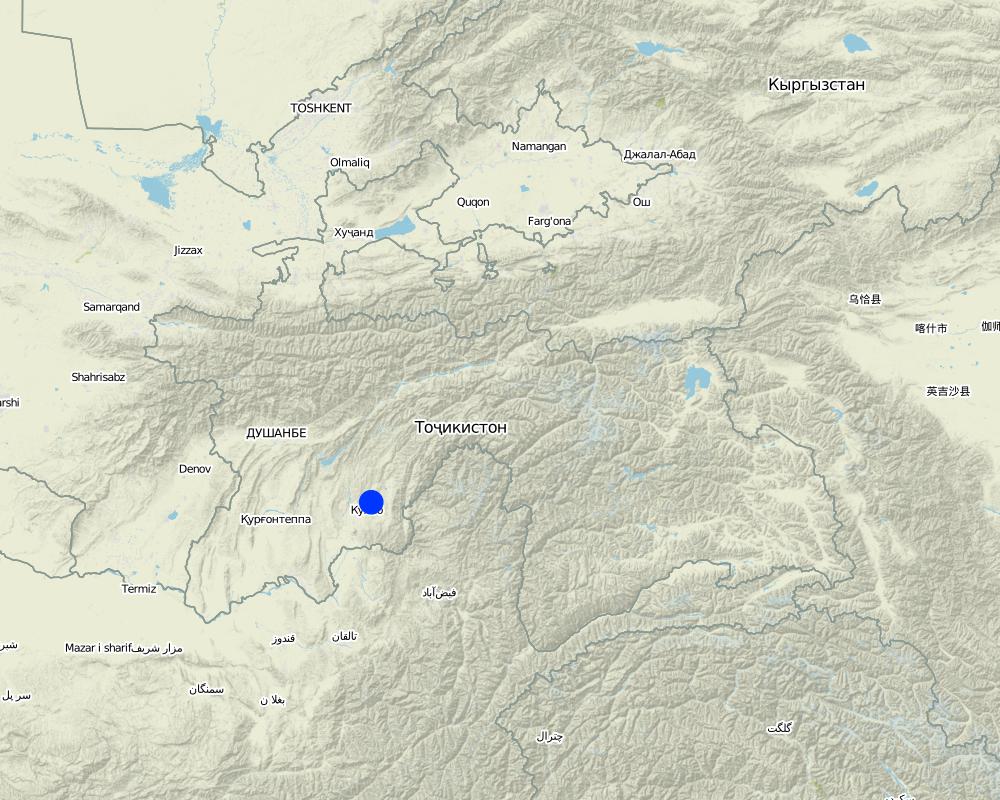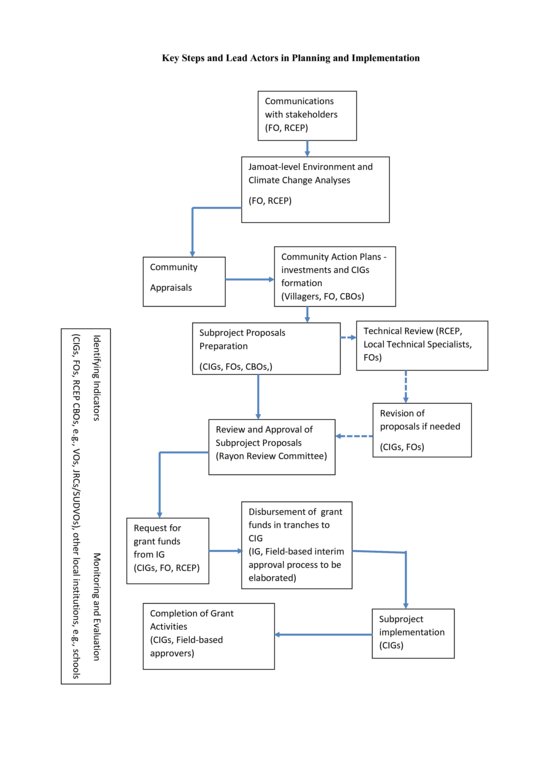Veterinary clinic contributing to the health level of the livestock and improved pastures through prevention activities [ប្រទេសតាហ្ស៊ីគីស្ថាន]
- ការបង្កើត៖
- បច្ចុប្បន្នភាព
- អ្នកចងក្រង៖ Kamolidin Abdulloev
- អ្នកកែសម្រួល៖ –
- អ្នកត្រួតពិនិត្យ Farrukh Nazarmavloev
Дорухонаи байтори
approaches_3903 - ប្រទេសតាហ្ស៊ីគីស្ថាន
ពិនិត្យមើលគ្រប់ផ្នែក
ពង្រីកមើលទាំងអស់ បង្រួមទាំងអស់1. ព័ត៌មានទូទៅ
1.2 ព័ត៌មានលម្អិតពីបុគ្គលសំខាន់ៗ និងស្ថាប័នដែលចូលរួមក្នុងការវាយតម្លៃ និងចងក្រងឯកសារនៃវិធីសាស្ត្រផ្សព្វផ្សាយ
ឈ្មោះគម្រោងដែលបានចងក្រងឯកសារ/ វាយតម្លៃលើវិធីសាស្ត្រផ្សព្វផ្សាយ (បើទាក់ទង)
Environmental Land Management and Rural Livelihoods (ELMAR)ឈ្មោះអង្គភាពមួយ (ច្រើន) ដែលបានចងក្រងឯកសារ/ វាយតម្លៃលើវិធីសាស្ត្រផ្សព្វផ្សាយ (បើទាក់ទង)
Committee for Environment Protection of Tajikistan (Committee for Environment Protection of Tajikistan) - ប្រទេសតាហ្ស៊ីគីស្ថាន1.3 លក្ខខណ្ឌទាក់ទងទៅនឹងការប្រើប្រាស់ទិន្នន័យដែលបានចងក្រងតាមរយៈវ៉ូខេត
តើពេលណាដែលទិន្នន័យបានចងក្រង (នៅទីវាល)?
24/06/2018
អ្នកចងក្រង និង(បុគ្គលសំខាន់ៗ)យល់ព្រមទទួលយកនូវលក្ខខណ្ឌនានាទាក់ទងទៅនឹងការប្រើប្រាស់ទិន្នន័យដែលបានចងក្រងតាមរយៈ វ៉ូខេត:
បាទ/ចា៎
2. ការពណ៌នាអំពីវិធីសាស្ត្រផ្សព្វផ្សាយ SLM
2.1 ពណ៌នាសង្ខេបខ្លីពីវិធីសាស្ត្រផ្សព្វផ្សាយ
Improvement of the level of care and breeding cattle by opening a veterinary drugstore by this way to support livestock keepers somehow control pastures lands and livestock quantity
2.2 ពណ៌នាលម្អិតពិវិធីសាស្ត្រផ្សព្វផ្សាយ
ពណ៌នាលម្អិតពិវិធីសាស្ត្រផ្សព្វផ្សាយ:
Animal diseases would not mention by livestock keepers as a problem. Likely because they themselves perceive the present losses as unavoidable. The veterinary staff, however, estimates the annual losses of livestock due to diseases at 5-10%. Reasons given for this is that vaccines are often not made available for entire herd populations, but are only sufficient for around 70% of the total number of animals. Furthermore are some vaccination only carried out in case of an outbreak of disease (ring vaccination) and not as a routine. It was also noted that the privatization of veterinary services is problematic as the taxation of services is making it difficult for the vets in the rural areas to make a living out of their service provision. According to data infections diseases, such as gangrene, foot and mouth disease, brucellosis and other infectious diseases were registered in this rural area so depending on the season monitoring is conducted. Except for infectious diseases, there are other parasites infections are met in this rural area. In the case of not carrying out vaccination in a timely manner they will be spread, as well as failure to timely prevent other diseases leads to the loss of livestock, which will also reduce the economic level of the population and their living. This was the first problem, the second and the main is the balancing of fodder and livestock, and only villagers need to discuss how either the production of fodder can be increased or the number of animals can be reduced in order to achieve the potential production level of the animals, for which balancing fodder and number of livestock is a precondition. There are several options for how the balance between fodder and animals can be restored. The villagers need to have a plan and it would stipulate controlled grazing measures, this group does not have a plan but they some of the prevention activities. As the result of the approach, they opened livestock registered book that they regularly monitored the number of the livestock, calendar with the type of disease season, breeding process, mortality of the livestock, artificial insemination of animals at the clinic is planned to open, and species of birds. Additionally, vet clinic group specialists have been trained a different type of the training on; pasture assessment practical, how to develop and implement a scheme for rotational grazing, how to monitor potential pasture yields, determining the quality of fodder and feeds, housing process and so on. On behalf of the project for the representatives all the groups been provided composting, mulching, managing salinization, intercropping on slopes, drip irrigation, low-cost watering techniques, solar greenhouses, drought-resistant crops, bee-keeping, mixed fruit orchards, local varieties nurseries, rotational grazing, livestock breeding and maintaining, strategic watering points, use of perennial forage, solar energy technologies, marketing options and opportunities trainings through the facilitation organisation
2.3 រូបភាពនៃវិធីសាស្ត្រផ្សព្វផ្សាយ
2.5 ប្រទេស/តំបន់/ទីតាំងកន្លែង ដែលវិធីសាស្ត្រផ្សព្វផ្សាយត្រូវបានអនុវត្តន៍
ប្រទេស:
ប្រទេសតាហ្ស៊ីគីស្ថាន
តំបន់/រដ្ឋ/ខេត្ត:
Kulob Region, Kulob District
បញ្ជាក់បន្ថែមពីលក្ខណៈនៃទីតាំង:
Ziraki Jamoat, Gulbogh Village
មតិយោបល់:
An approach implemented in Kulob district, Jamoat Ziraki, Gubogh village
Map
×2.6 កាលបរិច្ឆេទនៃការចាប់ផ្តើម និងបញ្ចប់នៃវិធីសាស្រ្តផ្សព្វផ្សាយនេះ
សូមបញ្ជាក់ឆ្នាំដែលបានបង្កើតឡើង:
2015
ឆ្នាំបញ្ចប់ (ប្រសិនបើវិធីសាស្ត្រផ្សព្វផ្សាយត្រូវបានឈប់ប្រើប្រាស់):
2017
មតិយោបល់:
While carrying out preventive measures and treatment of farm animals rural people spend their service fees for the purchase of medicines and equipment. In the future, the head of the group is responsible to care of and make the veterinary clinic operation more sustainable.
2.7 ប្រភេទនៃវិធីសាស្ត្រផ្សព្វផ្សាយ
- ផ្អែកលើគម្រោង/កម្មវិធី
2.8 គោលបំណង/ទិសដៅសំខាន់នៃវិធីសាស្ត្រផ្សព្វផ្សាយ
The main goal of approach is to prevent infectious diseases of animals in a timely manner and infection of domestic animals, as well as to provide treatment and preventive measures for infectious diseases, such as immunization of cattle and small cattle and improving pasture lands through prevention activities
2.9 លក្ខខណ្ឌអនុញ្ញាត ឬរារាំងការអនុវត្តន៍បច្ចេកទេសដែលស្ថិតនៅក្រោមវិធីសាស្រ្តផ្សព្វផ្សាយ
សង្គម/វប្បធម៌/ និងតម្លៃនៃសាសនា
- រារាំង
Besides, to purchase and increase good breeds of cattle adapted to the climate in this region. It is worth to note that the rural people were not aware of veterinary information. That resulted in that infectious diseases were spread because the population had eaten meat or sold in the market. Along with the implementation of this subproject these problems are disappearing.
បរិបទនៃស្ថាប័ន
- រារាំង
Non of institutions was functionedThe CIG head is Isroil Nazarov and an accountant is Hussein Abdurahmonov. They are responsible for the subproject activities implementation, make all their efforts and put their enthusiasm for the successful implementation. While carrying out preventive measures and treatment of farm animals rural people spend their service fees for the purchase of medicines and equipment. In the future, the head of the group is responsible to care of and make the veterinary clinic operation more sustainable.
ចំណេះដឹងស្តីពី SLM និងការទទួលបានការគាំទ្រផ្នែកបច្ចេកទេស
- រារាំង
The livestock keepers and land users does not have sufficient knowledge to manage their lands On behalf of the project for the reprezentatives all the groups been provided composting, mulching, managing salinization, inter cropping on slopes, drip irrigation, low-cost watering techniques, solar greenhouses, drought resistant crops, bee-keeping, mixed fruit orchards, local varieties nurseries, rotational grazing, livestock breeding and maintaining, strategic watering points, use of perennial forage, solar energy technologies, marketing options and opportunities trainings through the facilitation organisation
3. ការចូលរួម និងតួនាទីរបស់ភាគីពាក់ព័ន្ធ
3.1 អ្នកពាក់ព័ន្ធដែលបានចូលរួមក្នុងវិធីសាស្ត្រផ្សព្វផ្សាយ និងតួនាទីរបស់ពួកគេ
- អ្នកប្រើប្រាស់ដីក្នុងតំបន់/សហគមន៍
CIG Members
The CIG head is Isroil Nazarov and an accountant is Hussein Abdurahmonov. They are responsible for the subproject activities implementation, make all their efforts and put their enthusiasm for the successful implementation. While carrying out preventive measures and treatment of farm animals rural people spend their service fees for the purchase of medicines and equipment. In the future, the head of the group is responsible to care of and make the veterinary clinic operation more sustainable.
- អ្នកឯកទេសគ្រប់គ្រងដីប្រកបដោយចីរភាព/ទីប្រឹក្សាបច្ចេកទេសកសិកម្ម
FOs and Academys
Reprezentatives been involved during the TOT trainings
- អង្គការក្រៅរដ្ឋាភិបាល
FOs
FOs provided their services to facilitate community mobilization, and preparation and implementation of sub-projects, as well as to strengthen the capacity of community based groups to undertake their respective project responsibilities
- រដ្ឋាភិបាលថ្នាក់មូលដ្ឋាន
Local hukumat and Jamoat
Jamoat representatives was involved in Participatory Rural Appraisal (PRA) that was used as the main pre-assessment mechanism to analyze socio-economic and environmental situation in the selected pilots, The RRC(Rayon Reviw Committee) will consider the combination of proposed sub-projects within the overall context of the rayon and project.
3.2 ការចូលរួមរបស់អ្នកប្រើប្រាស់ដីក្នុងតំបន់/ សហគមន៍ក្នុងតំបន់ក្នុងដំណាក់កាលផ្សេងគ្នានៃវិធីសាស្រ្តផ្សព្វផ្សាយ
| ការចូលរួមរបស់អ្នកប្រើប្រាស់ដីក្នុងតំបន់/សហគមន៍ក្នុងតំបន់ | សូមបញ្ជាក់នរណាត្រូវបានចូលរួម ព្រមទាំងពណ៌នាសកម្មភាពទាំងនោះ | |
|---|---|---|
| ការចាប់ផ្តើម/ការលើកទឹកចិត្ត | អន្តរកម្ម | There are 274 households residing in the village with the total number of 2225 people. The CIG head is Isroil Nazarov. He is as the specialist responsible for the subproject/approach activities implementation, make all their efforts and put their enthusiasm for the successful implementation |
| ការរៀបចំផែនការ | អសកម្ម | The local land users prioritized investments based on a fixed budget for each type of rural investment determined by the number of households and on behalf of the CAP participants decided on the allocation of investments to groups of households (Common Interest Groups, CIGs) using rules that limit the funding for any one household. At least 50% of the village households should participate in either farm production or land resource management investments. |
| ការអនុវត្តន៍ | អន្តរកម្ម | Villagers made grant allocation decisions. CIGs managed grant funds and purchased needed materials and products. |
| ការត្រួតពិនិត្យ និងវាយតម្លៃ | អសកម្ម | Local land users have activelly participated during the monitoring |
3.3 គំនូសបំព្រួញ (ប្រសិនបើមាន)
ការពណ៌នា:
Here is the key steps and actors in the planning and implementation of rural investments. Not all possible participants in these steps are included since local situations may vary and will need to be taken into account during planning and implementation.
អ្នកនិពន្ធ:
ELMARL POM
3.4 ការសម្រេចចិត្តលើការជ្រើសរើសបច្ចេកទេស SLM
សូមបញ្ជាក់តើអ្នកណាជាអ្នកបានសម្រេចចិត្តក្នុងការជ្រើសរើសបច្ចេកទេសដើម្បីយកមកអនុវត្តន៍:
- អ្នកប្រើប្រាស់ដី ដោយមានការគាំទ្រពីអ្នកជំនាញឯកទេស SLM
ចូរពន្យល់:
The local land users prioritized investments based on a fixed budget for each type of rural investment determined by the number of households and on behalf of the CAP participants decided on the allocation of investments to groups of households (Common Interest Groups, CIGs) using rules that limit the funding for any one household
សូមបញ្ជាក់ តើការសម្រេចធ្វើឡើងដោយផ្អែកលើអ្វីជាមូលដ្ឋាន:
- វាយតម្លៃទៅលើចំណេះដឹងស្តីអំពី SLM ដែលបានចងក្រងជាឯកសារបានត្រឹមត្រូវ (ផ្អែកលើភស្តុតាងជាមូលដ្ឋានដើម្បីសម្រេចចិត្ត)
- Project initial phases
4. ជំនួយបច្ចេកទេស ការកសាងសមត្ថភាព និងការគ្រប់គ្រងចំណេះដឹង
4.1 ការកសាងសមត្ថភាព/ បណ្តុះបណ្តាល
តើវគ្គបណ្តុះបណ្តាលបានផ្តល់ឱ្យអ្នកប្រើប្រាស់ដី/អ្នកពាក់ព័ន្ធផ្សេងៗទៀតដែរឬទេ?
បាទ/ចា៎
សូមបញ្ជាក់តើអ្នកណាត្រូវបានបណ្តុះបណ្តាល:
- អ្នកប្រើប្រាស់ដី
- បុគ្គលិកចុះទីវាល/អ្នកផ្តល់ប្រឹក្សាយោបល់
ប្រសិនទាក់ទង សូមបញ្ជាក់ ភេទ អាយុ ស្ថានភាពគ្រួសារ ជនជាតិដើមភាគតិច។ល។:
Provided participation of the male and female during the training process
ទម្រង់នៃការបណ្តុះបណ្តាល:
- អនុវត្តន៍ជាមួយការងារ
- ពីកសិករទីកសិករ
- ការប្រជុំជាសាធារណៈ
ប្រធានបទបណ្តុះបណ្តាល:
Grant allocation mechanisms. Fund flow arrangements, management and technical
មតិយោបល់:
Trainings included such king themes; composting, mulching, managing salinization, intercropping on slopes, drip irrigation, low-cost watering techniques, solar greenhouses, drought-resistant crops, bee-keeping, mixed fruit orchards, local varieties nurseries, rotational grazing, Livestock breeding and maintaining, strategic watering points, use of perennial forage, solar energy technologies, marketing options and opportunities,
4.2 សេវាផ្តល់ប្រឹក្សាយោបល់
តើអ្នកប្រើប្រាស់ដីបានទទួលនូវសេវាផ្តល់ប្រឹក្សាដែរ ឬទេ?
បាទ/ចា៎
សូមបញ្ជាក់ប្រសិនបើសេវាកម្មប្រឹក្សាយោបល់ត្រូវបានផ្តល់ឱ្យ:
- នៅលើដីរបស់អ្នកប្រើប្រាស់ដី
- នៅមជ្ឈមណ្ឌលជាអចិន្ត្រៃ
ពណ៌នា/ពន្យល់:
Jamoat representatives and also local vet specialists from the district advise them
4.3 ការពង្រឹងសមត្ថភាពស្ថាប័ន (ការអភិរឌ្ឍន៍អង្គភាព)
តើស្ថាប័នទាំងអស់ត្រូវបានបង្កើតឡើង ឬពង្រឹងសមត្ថភាពតាមរយៈវិធីសាស្ត្រផ្សព្វផ្សាយដែរ ឬទេ?
- បាទ/ច៎ា តិចតួច
សូមបញ្ជាក់ថាតើស្ថាប័នត្រូវបានពង្រឹង ឬបង្កើតឡើងនៅត្រឹមកម្រិតណា(ច្រើន)?
- ថ្នាក់មូលដ្ឋាន
ចូពណ៌នាពីស្ថាប័ន តួនាទី និងទំនួលខុសត្រូវ សមាជិក ។ល។:
The Common Interest Groups formed in the villages on behalf households and enhanced their knowledge. And the project provides small-scale grants at the village level for groups of households (CIG) to implement rural production and land management investments, as well as related small-scale infrastructure investments. Villages will prioritize investments based on a fixed budget for each type of rural investment, determined by the number of households.
សូមបញ្ជាក់ប្រភេទនៃការគាំទ្រ:
- ហិរញ្ញវត្ថុ
- ការកសាងសមត្ថភាព/ បណ្តុះបណ្តាល
សូមផ្តល់ព័ត៌មានបន្ថែមទៀតឱ្យបានលម្អិត:
Project-financed grants to CIGs for each investment under categories of rural production and land management investments, as well as related small-scale infrastructure investments that will not exceed US$7,000 and will require a match of 25% in beneficiary contributions which may be in cash or in-kind
4.4 ការត្រួតពិនិត្យ និងវាយតម្លៃ
តើការត្រួតពិនិត្យ និងវាយតម្លៃគឺជាផ្នែកមួយនៃវិធីសាស្ត្រដែរឬទេ?
ទេ
4.5 ការស្រាវជ្រាវ
តើការស្រាវជ្រាវ គឺជាផ្នែកមួយនៃវិធីសាស្រ្តដែរឬទេ?
ទេ
5. ថវិកា និងសម្ភារៈឧបត្ថម្ភពីខាងក្រៅ
5.1 ថវិកាប្រចាំឆ្នាំសម្រាប់ផ្សព្វផ្សាយ SLM
ប្រសិនបើចំនួនពិតប្រាកដនៃថវិកាប្រចាំឆ្នាំមិនត្រូវបានដឹងច្បាស់ សូមប្រាប់ពីចន្លោះនៃថវិកានោះ:
- 2,000-10,000
មតិយោបល់ (ឧ. ប្រភពសំខាន់នៃមូលនិធិ/ម្ចាស់ជំនួយចំបង):
GEF/PPCR through the WB
5.2 ការគាំទ្រផ្នែកហិរញ្ញវត្ថុ / សម្ភារៈដែលបានផ្តល់ទៅឱ្យអ្នកប្រើប្រាស់ដី
តើអ្នកប្រើប្រាស់ដីបានទទួលការគាំទ្រផ្នែកហិរញ្ញវត្ថ/សម្ភារៈសម្រាប់ការអនុវត្តន៍បច្ចេកទេសដែរឬទេ:
បាទ/ចា៎
ប្រសិនបាទ/ច៎ា សូមបញ្ជាក់ប្រភេទ(ច្រើន)នៃការគាំទ្រ លក្ខខណ្ឌ និងអ្នកផ្តល់ឱ្យ(ច្រើន):
The project will finance investments in three categories that are expected to improve household assets and sustainable land management, and build climate resilience, examples ofwhich are listed below: (i) Farm Production: field and horticultural crop productivity and diversity (e.g., crop rotations, drought resistant varieties, diversified cropping regimes, community seed funds, low-cost greenhouses), livestock production efficiency (e.g., breed choice, veterinary services), agro-processing and market access;(ii) Land Resource Management: pasture management (e.g., fodder productivity through appropriate species, rotational grazing, watering holes, growing perennials on slopes), watermanagement (e.g., drip irrigation and similar measures, water harvesting), soil fertility (e.g.,composting, mulch crops) integrated pest management (e.g., use of pheromone traps,biological controls) and sustainable sloping lands cultivation (including terracing, inter cropped orchards and woodlots, shelter-belts); and (iii) Small-scale Rural Production Infrastructure: irrigation/drainage system rehabilitation, minor transport infrastructure rehabilitation (e.g., repair of bridges), renewable energy (e.g.,low cost solar energy, and energy efficiency measures (e.g., improved stoves, insulation).Project-financed grants to CIGs for each investment under categories (i), (ii), and (iii) will not exceed US$7,000 and will require a match of 25% in beneficiary contributions which may be in cash or in-kind. Beneficiaries of rural infrastructure investments (category iii above) will have to contribute at least 5% of the total cost in cash at inception. Grants under this subcomponent will be disbursed in tranches directly to beneficiaries or groups to their own bank account with Amonatbank that has branches in most districts.
5.3 សូមបញ្ជាក់ពីធាតុចូលត្រូវបានផ្តល់បដិភាគ (រួមទាំងកម្លាំងពលកម្ម)
- គ្មាន
ប្រសិនបើកម្លាំងពលកម្មធ្វើដោយអ្នកប្រើប្រាស់ដី តើវាជាធាតុចូលដ៏សំខាន់មួយដែរ ឬទេ:
- ដោយស្ម័គ្រចិត្ត
មតិយោបល់:
The CIG group contributed more then 25 % from the total subproject/approach
5.4 ឥណទាន
តើឥណទានដែលបានផ្តល់នៅក្រោមវិធីសាស្ត្រផ្សព្វផ្សាយសម្រាប់សកម្មភាព SLM នេះយ៉ាងដូចម្តេច?
ទេ
5.5 ការលើកទឹកចិត្ត ឬវិធីសាស្ត្រដ៏ទៃទៀត
តើមានការលើកទឹកចិត្តផ្សេងទៀត ឬឧបករណ៍ប្រើប្រាស់ដើម្បីលើកកម្ពស់ការអនុវត្តន៍បច្ចេកទេស SLM?
ទេ
6. ការវិភាគរកផលប៉ះពាល់ និងសេចក្តីសន្និដ្ឋាន
6.1 ផលប៉ះពាល់នៃវិធីសាស្ត្រផ្សព្វផ្សាយ
តើវិធីសាស្ត្រផ្សព្វផ្សាយបានផ្តល់សិទ្ធិអំណាចដល់អ្នកប្រើប្រាស់ដី ធ្វើឱ្យប្រសើរឡើងនូវការចួលរួមអ្នកពាក់ព័ន្ធ?
- ទេ
- បាទ/ច៎ា បន្តិចបន្តួច
- បាទ/ច៎ា ជាមធ្យម
- បាទ/ច៎ា បានខ្លាំង
There are 274 households residing in the village with total number of 2225 people. The CIG head is Isroil Nazarov and an accountant is Hussein Abdurahmonov. They are responsible for the subproject activities implementation, make all their efforts and put their enthusiasm for the successful implementation. While carrying out preventive measures and treatment of farm animals rural people spend their service fees for the purchase of medicines and equipment. In the future, the head of the group is responsible to care of and make the veterinary clinic operation more sustainable
On behalf of the project for the reprezentatives all the groups been provided composting, mulching, managing salinization, inter cropping on slopes, drip irrigation, low-cost watering techniques, solar greenhouses, drought resistant crops, bee-keeping, mixed fruit orchards, local varieties nurseries, rotational grazing, livestock breeding and maintaining, strategic watering points, use of perennial forage, solar energy technologies, marketing options and opportunities trainings through the facilitation organisation that will contribute to implement and maitain apprach
តើវិធីសាស្ត្រផ្សព្វផ្សាយនេះធ្វើឱ្យចំណេះដឹងប្រសើឡើង និងសមត្ថភាពរបស់អ្នកប្រើប្រាស់ដីក្នុងការអនុវត្តន៏ SLM?
- ទេ
- បាទ/ច៎ា បន្តិចបន្តួច
- បាទ/ច៎ា ជាមធ្យម
- បាទ/ច៎ា បានខ្លាំង
Trainings were organized and most of them had direct and indirect relation to SLM projects
6.2 ការលើកទឹកចិត្តចម្បងៗរបស់អ្នកប្រើប្រាស់ដីសម្រាប់ការអនុវត្តបច្ចេកទេស SLM
- បង្កើនផលិតកម្ម
The vet specialists will advise livestock keepers regarding the new breeds and also the timely manner of the vaccination process will contribute to the productivity of the livestock
- ការកាត់បន្ថយការធ្លាក់ចុះគុណភាពដី
As the result of the approach, they opened livestock registered book that they regularly monitored the number of the livestock, calendar with the type of disease season, breeding process, mortality of the livestock, artificial insemination of animals at the clinic is planned to open, and species of birds. Additionally, vet clinic group specialists have been trained a different type of the training on; pasture assessment practical, how to develop and implement a scheme for rotational grazing, how to monitor potential pasture yields, determining the quality of fodder and feeds, housing process training will contribute to reducing degradation in pastures.
- លើកកម្ពស់ចំណេះដឹង និងជំនាញ SLM
There were organised a huge number of different type of trainings that are all were relative to the SLM
6.3 សកម្មភាពផ្សព្វផ្សាយដែលប្រកបដោយចីរភាព
តើអ្នកប្រើប្រាស់ដីអាចធ្វើឱ្យមានចីរភាពនូវអ្វីដែលត្រូវបានអនុវត្តន៍តាមរយៈវិធីសាស្ត្រផ្សព្វផ្សាយដែរឬទេ(ដោយពុំមានការគាំទ្រពីអ្នកខាងក្រៅ)?
- បាទ/ចា៎
ប្រសិនបាទ/ច៎ា សូមរៀបរាប់ថាធ្វើយ៉ាងម៉េច:
The CIG head is Isroil Nazarov and an accountant is Hussein Abdurahmonov. They are responsible for the subproject activities implementation, make all their efforts and put their enthusiasm for the successful implementation. While carrying out preventive measures and treatment of farm animals rural people spend their service fees for the purchase of medicines and equipment. In the future, the head of the group is responsible to care of and make the veterinary clinic operation more sustainable.
6.4 ភាពខ្លាំង/ គុណសម្បត្តិនៃវិធីសាស្ត្រផ្សព្វផ្សាយ
| ភាពខ្លាំង/ គុណសម្បត្តិ/ ឱកាស ទស្សនៈរបស់បុគ្គលសំខាន់ៗ |
|---|
| High-qualified specialists in the group |
| Office speace, where they will be able to conduct meetings with the farmers |
| Required knowledge |
6.5 ភាពខ្សោយ/ គុណវិបត្តិនៃវិធីសាស្ត្រ និងរកដំណោះស្រាយ
| ភាពខ្សោយ/ គុណវិបត្តិ/ ហានិភ័យក្នុងទស្សនៈរបស់បុគ្គលសំខាន់ៗ | តើបច្ចេកទេសទាំងនោះបានដោះស្រាយបញ្ហាដូចម្តេច? |
|---|---|
| Knowledge on the market analysis, fundraising, business planning | They need additional support on capacity building |
| Support on behalf of the district local government | They need to work more closely with the district and local government |
| New sources to go ahead | The group needs to come up with the requested letters to the sufficient donors or government funds |
7. ឯកសារយោង និងវេបសាយ
7.1 វិធីសាស្ត្រ/ ប្រភពនៃព័ត៌មាន
- ការសម្ភាសន៍ជាមួយអ្នកប្រើប្រាស់ដី
CIG Members
- ការសម្ភាសន៍ជាមួយអ្នកជំនាញ/ ឯកទេស
ELMARL Specialists
7.2 ឯកសារយោងដែលបានចេញផ្សាយ
ចំណងជើង អ្នកនិពន្ធ ឆ្នាំ ISBN:
ELMARL Annual Report 2017
មានប្រភពមកពីណា? ថ្លៃដើមប៉ុន្មាន?
Committee of Environment Protection of RT.
7.3 ចូលទៅទាញយកឯកសារពាក់ព័ន្ធដែលមានលើបណ្តាញអ៊ិនធឺណែត
ចំណងជើង/ ពណ៌នា:
ELMARL documents on SLM Knowledge Management platform
វេបសាយ:
https://slmtj.net
ការតភ្ជាប់ និងម៉ូឌុល
ពង្រីកមើលទាំងអស់ បង្រួមទាំងអស់ការតភ្ជាប់
គ្មានការតភ្ជាប់
ម៉ូឌុល
គ្មានម៉ូឌុល


